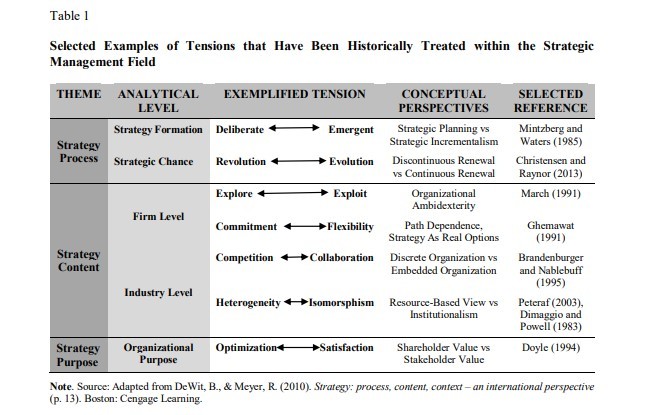
دانلود رایگان مقاله نوع شناسی مبتنی بر پارادوکس برای حالات سازمانی مرتبط با دوسوتوانی

چکیده
این مقاله به مسائل زیر می پردازد: چگونه سازمانها به مرور زمان دوسو توان می شوند, شناسایی الزامات سازمانها برای تبدیل شدن به دوسوتوان، درک چگونگی پدیدار شدن دوسوتوانی به عنوان یک ویژگی سازمانی و همچنین بررسی ارتباطات احتمالی خاصیت دوسوتوانی و سازماندهی فعالیتها و کارهای شرکت. با ساخت مفهوم رابطه اکتشاف-بهره برداری به عنوان یک رابطه پارادوکس، دو شرط لازم برای سازماندهی دوسوتوانی را پیش می بریم: پرورش تاکتیک های مقابله با پارادوکس و جلوگیری از تله های مربوط به پارادوکس. تداخل این دو شرط به یک نوع شناسی با چهار حالت سازمانی مرتبط با دوسوتوانی منجر می شود: سازمان های فاقد دوسوتوانی، سازمان های یکپارچه، سازمان های دوسوتوان برای کوتاه مدت و سازمان های دوسوتوان برای بلند مدت. در این مقاله, نقاط قوت و چالشهای مرتبط با سازماندهی برای دوسوتوانی مشخص شده است و پیامدهای نظری، عملی و سیاست گذاری مورد بحث و بررسی قرار می گیرند.
مقدمه
دوسوتوانی سازمانی در نوشته های مدیریت استراتژیک بسیار مورد توجه قرار گرفته است. تعداد مطالعات در مورد این موضوع در ژورنال های پیشروی مدیریت به طور پیوسته با گذشت زمان افزایش یافته است و یکی از ماندگارترین ایده ها در علوم سازمان را تشکیل می دهد (Raisch, Birkinshaw, Probst و tushman، 2009). گزاره اصلی این ساختار بیان می کند که موفقیت یک سازمان حول محوریت توانایی آن در بهره برداری از توانمندی های فعلی آن و در عین حال اکتشاف صلاحیت های اساسی جدید می چرخد (Levinthal و March، 1993 ؛ March 1991). علاوه بر این، این ساختار به طور بالقوه توضیح می دهد که چرا داده های تجربی نشان می دهند که تنها تعداد معدودی از سازمانها تحت فشارهای سودهای کوتاه مدت و بقای طولانی مدت, در برقراری تعادل موفق بوده اند (Aldrich & Rueff ، 1999 ؛ Coad، 2009 ؛ Coad & Tamvada، 2008؛ Feser، 2012؛ O´Reilly، Harreld، & Tushman، 2009؛ Simonetti، 1996؛ Stubart & Knight، 2006). نوشته های در حال گسترش در مورد این ساختار، زمینه مشترکی برای پژوهش را برای محققان فراهم می آورد. با این حال، هنوز هم شامل سوالات باز می باشد که خواستار تحقیقات بیشتر است.
به عنوان مثال، یک موضوع بسیار مشترک اینست که دوسو توانی سازمانی چیست. مقاله برجسته March (1991) پیشنهاد كرد كه بهره برداری و اكتشاف دو نوع اساساً متفاوت از فعالیت هایی هستند كه شرکت ها توجه و منابع خود را بین آنها تقسیم می كنند. در واقع، نوشته ها در مورد این موضوع بر اساس این مفهوم اصلی و اولیه March (1991) است که دوسوتوانی سازمانی به عنوان توانایی یک شرکت برای برقراری تعادل مؤثر بین اکتشاف (مانند پالایش، کارآیی، انتخاب و پیاده سازی) و بهره برداری (مانند جستجو، تغییر، آزمایش و کشف) تعریف می شود.
همچنین، به طور گسترده ای پذیرفته شده است که دلیل اینکه شرکتها باید دوسوتوان شوند, با موفقیت طولانی مدت و دوسوتوانی سازمانی در ارتباط است. اگرچه مطالعات, نیاز به شفاف سازی این پیوند را از طریق تلاش های طولی (Cao، Gedajlovic، & Zhang، 2009؛ Simsek، 2009) به منظور جلوگیری از ادعاهای زائد اغلب مرتبط با دیدگاه مبتنی بر منبع (Priem و Butler, 2001; Williamson, 1999; Winter, 2003; Zott ، 2003) نشان داده اند، این ادعا که دوسوتوانی سازمانی به طول عمر سالم یک شرکت کمک می کند تا حدود زیادی درست است. علاوه بر این، مطالعات تجربی در مقیاس بزرگ، کار مفهومی ارائه دهنده شواهدی از ارتباط کلی دوسوتوانی سازمان با عملکرد (Gibson & Birkinshaw، 2004؛ He & Wong، 2004؛ Lubatkin، Simsek، Ling، & Veiga، 2006) را ارائه کرده است.
با این حال، هنوز سوالات بازی وجود دارد که خواستار تحقیق بیشتر هستند. این سوالات شامل مواردی در رابطه با چگونگی دوسوتوان شدن سازمان ها، مانند شناسایی الزامات احتمالی سازمانها برای دوسوتوان شدن و درک چگونگی ظهور دوسوتوانی به عنوان یک ویژگی سازمانی، و همچنین بررسی ارتباطات احتمالی خاصیت دوسوتوانی و سازماندهی فعالیتها و کارهای شرکت می باشند.
حتی اگر چندین مطالعه نمونه های جزئی را ارائه نموده باشند (O'Reilly & Tushman، 2011) یا با ظهور دوسوتوانی در موقعیت های خاص، مانند تلاش های توسعه محصول جدید (Andriopoulos & Lewis، 2009؛ Chang، Hughes، and Hotos، 2011) مقابله کرده باشند, این زمینه هنوز درک کاملی از چگونگی پرورش و حفظ دوسوتوانی سازمانها به عنوان یک ویژگی سازمانی ارائه نداده است. شاید Gupta, Smith و Shalley (2006، ص 697) بهترین اظهار نظر را در این مورد داشته باشند كه "اگرچه در مورد لزوم توازن بهره برداری و اكتشاف, توافق نسبی وجود دارد، در مورد چگونگی دستیابی به این توازن شفافیت کمی وجود دارد." تحقیقات تا به امروز به طور معمول فقط یک متغیر را برای توضیح دوسوتوانی سازمانی، مانند ساختارهای دوگانه (Benner & Tushman ، 2003)، زمینه رفتاری (Gibson & Birkinshaw ، 2004) یا انسجام رفتاری یک تیم مدیریت ارشد (TMT) به کار گرفته اند (Lubatkin و همکاران، 2006). با فقدان وجود مدلهای یکپارچه شامل چندین سطح از تجزیه و تحلیل (Gupta، Smith و Shalley، 2006)، مطالعات قبلی تاکنون "نظریه ای اساسی را " برای توضیح دوسوتوانی سازمانی (Simsek، 2009) ایجاد نکرده اند.
با هدف کمک به درک نحوه دوسوتوان شدن سازمانها به مرور زمان، ما ماهیت ساختار دوسوتوانی را مورد بررسی قرار داده ایم، دو مورد را برای سازمانها برای دوسوتوان بودن شناسایی کرده ایم و موضوعات مربوط به سازماندهی برای دوسوتوانی را بررسی کرده ایم. ما دو شرط لازم را برای توسعه دوسوتوانی را پیشنهاد می کنیم: پرورش تاکتیک های مقابله با پارادوکس و همچنین جلوگیری از تله های مربوط به پارادوکس. ارتباط متقابل این دو شرط ما را به یک نوع شناسی از چهار حالت مرتبط با دوسوتوانی می رساند که مستلزم ویژگی های متمایز سازماندهی است.
کمک پیش بینی شده این مقاله به این بحث شامل سه جنبه اصلی می باشد. اول، ما پیشنهاد می کنیم که مفهوم پارادوکس به درستی به ویژگی های متمایز روابط تنش زای بین اکتشاف و بهره برداری (یعنی مکمل ها و مخالفت های متقابل آن) را می پردازد. دوم، ما دو شرط لازم را برای پرورش و پایداری دوسوتوانی سازمانی مشخص می کنیم: استفاده از تاکتیک های مقابله با پارادوکس و جلوگیری از تله های مربوط به پارادوکس. سوم، ما چهار حالت سازمانی مختلف را استخراج می کنیم، که شکل گیری آنها بستگی به نحوه پرداختن به شرایط لازم دارد. یک نوع شناسی چهار حالتی, این حالات را سازماندهی می کند، که نقاط قوت و نواقص آن در مقابل سازماندهی برای دوسوتوانی در بین حالات مختلف متفاوت است.
Abstract
This paper addresses the question of how organizations become ambidextrous over time, identifying requirements for organizations to become ambidextrous, understanding how ambidexterity may emerge as an organizational property, as well as exploring likely connections of the ambidexterity property and organizing a firm’s activities and work. Conceptualizing the exploration-exploitation relationship as a paradoxical one, we advance two necessary conditions for organizing for ambidexterity: fostering paradox-coping tactics and precluding paradoxrelated traps. The interplay of these two conditions gives rise to a typology of four ambidexterity-related organizational states: ambidexterity-lacking organizations, monolithic organizations, short-term ambidextrous organizations and long-term ambidextrous organizations. The paper identifies each state’s distinct strengths and challenges concerning organizing for ambidexterity, and discusses theoretical, practical and policy-making implications.
Introduction
Organizational ambidexterity has received a lot of attention in strategic management literature. The number of studies on this topic in leading management journals has steadily increased over time, constituting one of the most enduring ideas in organization sciences (Raisch, Birkinshaw, Probst, & Tushman, 2009). The construct’s core proposition states that an organization’s success hinges on its ability to exploit its current capabilities while simultaneously exploring fundamental new competencies (Levinthal & March, 1993; March, 1991). Moreover, the construct is potentially relevant to explain why empirical data shows that only a few organizations have been successful in balancing contradictory pressures of short-term profits and long-term survival (Aldrich & Rueff, 1999; Coad, 2009; Coad & Tamvada, 2008; Feser, 2012; O´Reilly, Harreld, & Tushman, 2009; Simonetti, 1996; Stubart & Knight, 2006). The expanding literature on the construct offers a lot of common ground for researchers. However, it still includes open questions that call for further research.
For instance, there is a lot of common ground concerning what organizational ambidexterity is. Generally understood as the catalyst for the current interest in the construct (Raisch & Birkinshaw, 2008), March’s (1991) landmark paper essentially proposed that exploitation and exploration are two fundamentally different types of activities which firms divide their attention and resources between. Actually, literature on the topic builds on March’s (1991) seminal notion that organizational ambidexterity is defined by a firm´s ability to effectively balance both exploration (such as refinement, efficiency, selection and implementation) and exploitation (such as search, variation, experimentation and discovery).
Also, it is widely accepted that the reason why firms should become ambidextrous has to do with the connection between organizational ambidexterity and long-term success. Although studies have pointed out the need to clarify this link through longitudinal efforts (Cao, Gedajlovic, & Zhang, 2009; Simsek, 2009) in order to avoid tautological claims often associated with the resource-based view (Priem & Butler, 2001; Williamson, 1999; Winter, 2003; Zott, 2003), the assertion that organizational ambidexterity contributes to a firm’s healthy longevity is hardly challenged. Moreover, large-scale empirical studies have complemented conceptual work providing evidence of organizational ambidexterity’s general association with performance (Gibson & Birkinshaw, 2004; He & Wong, 2004; Lubatkin, Simsek, Ling, & Veiga, 2006).
However, there still are open questions demanding further research. These include issues associated with how organizations become ambidextrous, such as identifying the likely requirements for organizations to become ambidextrous and understanding how ambidexterity may emerge as an organizational property, as well as exploring likely connections of the ambidexterity property and organizing a firm’s activities and work.
Even though several studies have provided piecemeal examples (O’Reilly & Tushman, 2011) or tackled ambidexterity’s emergence in specific situations, such as in new product development efforts (Andriopoulos & Lewis, 2009; Chang, Hughes, & Hotho, 2011), the field still lacks a comprehensive understanding of how organizations foster and sustain ambidexterity as an organizational property. Perhaps Gupta, Smith and Shalley (2006, p. 697) put it best when they noted that, “although near consensus exists on the need for balance of exploitation and exploration, there is considerably less clarity on how this balance can be achieved”. Research to date has typically employed only one variable to explain organizational ambidexterity, such as dual structures (Benner & Tushman, 2003), behavioural context (Gibson & Birkinshaw, 2004), or top management team (TMT) behavioural integration (Lubatkin et al., 2006). Lacking integrative models spanning multiple levels of analysis (Gupta, Smith, & Shalley, 2006), previous studies thus far ‘have not generated an overarching theory’ to explain organizational ambidexterity (Simsek, 2009).
Aiming at contributing understanding on how organizations become ambidextrous over time, we have scrutinized the nature of the ambidexterity construct, identified two requirements for organizations to become ambidextrous, and explored issues related to organizing for ambidexterity. We propose two necessary conditions for developing ambidexterity: fostering paradox-coping tactics as well as precluding paradox-related traps. The interplay of these two conditions gives rise to a typology of four ambidexterity-related states, entailing distinct organizing features.
The envisaged contribution includes three main aspects. First, we suggest that the paradox notion properly addresses the distinct characteristics of the tension-like relationship between exploration and exploitation (namely its mutual complementarities and opposition). Second, we identify two necessary conditions for fostering and sustaining organizational ambidexterity: employing paradox-coping tactics and avoiding specific paradox-related traps. Third, we derive four different organizational states, whose formation depends on how the necessary conditions are addressed. A four-state typology organizes these states, whose strengths and deficiencies vis-à-vis organizing for ambidexterity differ among states.
